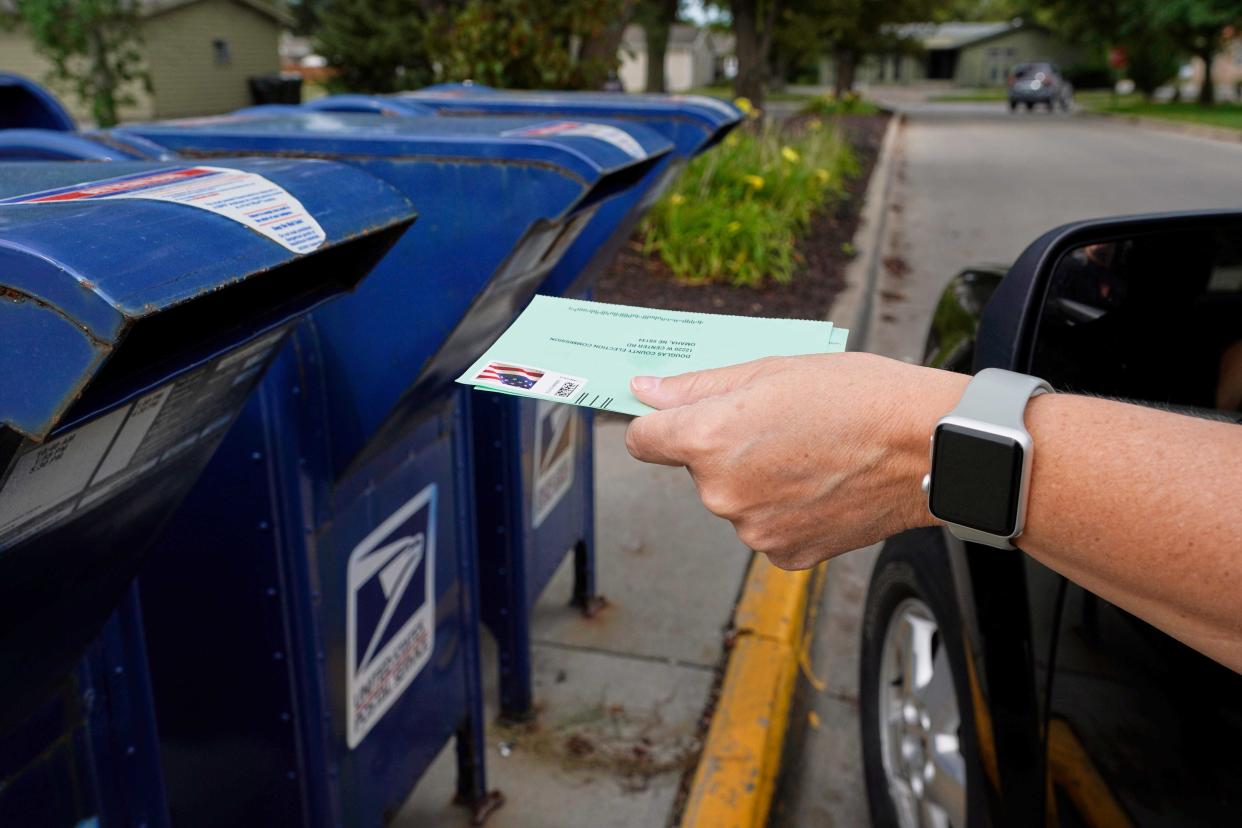Yes, it's safe to vote in Arizona's Aug. 2 primary election. Here's how we know

- Oops!Something went wrong.Please try again later.
Nobody has done more to undermine trust in voting than former President Donald Trump. Yet he’s urging Arizonans to cast a ballot – and to vote early.
“Make sure you return your Early Ballot,’’ he said in an email message to Arizonans as early voting for the Aug. 2 primary started this week.
The irony and hypocrisy from the man who inspired the “Stop the Steal” movement shouldn’t be lost on anyone, especially those who doubt that voting is safe and secure.
Trump and his supporters in and outside government have done everything imaginable to overturn the results of the 2020 presidential election – and to undermine the election system itself ever since.
They selected fake Republican electors, demanded secretaries of state in battleground states find enough votes for him, mounted an insurrection at the U.S. Capitol and wasted taxpayer money in a bogus “audit” of Maricopa County ballots.
Some even tried to outlaw early voting.
Election officials have addressed every bogus claim
Yet no effort to overturn the outcome worked because nobody stole votes from Trump. Elections workers did their jobs admirably, as they always do. Ballots were verified and counted correctly.
Republican Maricopa County Recorder Stephen Richer and the Maricopa County Board of Supervisors, which oversees elections in the state’s most populous county, have steadfastly addressed every single claim thrown at them to discredit the election process.
The county conducted its own audits following the 2020 vote, as it had done in previous elections. Auditors found “no problems with equipment, no manipulation of the software code, no malware, and no connection to the internet.”
And, no, ballots weren’t flown into the county from South Korea. No tabulated ballots were shredded, and the county didn’t delete election databases.
Even the Cyber Ninjas agreed that Trump lost
The Cyber Ninjas – which Senate President Karen Fann hired to conduct a farce of an “audit” – not only failed to prove any of these wild conspiracy theories, but its hand count of the votes reaffirmed that Trump lost the election.
Yet the Cyber Ninjas’ report raised questions about voter integrity and the county’s election process with no proof.
It’s worth noting that the Cyber Ninjas, which were reportedly paid millions with private donations, fought to keep records secret and eventually shut down after a judge ordered the release of the records, then fined the company $50,000 a day when it failed to do so.
In those records: Cyber Ninjas' emails touch on irony, deceit, challenge coins
The Cyber Ninjas no longer exist, and CEO Doug Logan is long gone. But the stolen election narrative remains, and the damage to the process that sustains our democratic society is real and lasting.
Too many Arizonans still erroneously believe the election was rigged against Trump. Prominent Republicans, including AZ GOP Chairwoman Kelli Ward, gubernatorial hopeful Kari Lake and other candidates for statewide office remain committed to promoting the Big Lie.
Don't let bad actors derail democracy
Arizona voters must understand the intent of those hellbent on discrediting the election process for their own gain (and to society’s detriment).
Voters should see the irony and hypocrisy of these shameless folks who cast doubt on the election system now urging voters to use that same system to get them elected.
Is the election system perfect? No. There’s always room for improvement. But the debunking of these false claims over the past two years should give voters full confidence that they’re just that – false.
By now, voters should also know that the concerted efforts of the Stop the Steal crowd are designed to undermine democracy itself.
A strong democracy requires trust in the systems and the institutions that oversee them. We’re not asking for anyone to turn a blind eye to those systems. To the contrary, learn about them, get informed and get involved.
Richer, the Maricopa County recorder, has been transparent about the process, providing timely information about how and where to vote.
The Maricopa County elections department mailed 1.4 million early ballots for the Aug. 2 primary. Arizona voters everywhere else also have the opportunity to vote early or in person. Voters can mail in their ballot or drop it off at any drop box or voting location in their respective county.
How to know your vote is safe and secure
Casting a ballot is our sacred duty as U.S. citizens. We should do it confidently, knowing that it is safe and secure.
How can you be sure of that? For starters, you should know each ballot is tied to a registered voter. To register, a person must present verifiable information about their eligibility. Election officials vet that information.
Early ballots are sent only to those who made a one-time request for it or signed up for the Active Early Voting List to get it automatically every election. Each ballot is specially designed to be read by tabulation equipment, which is certified by a federal agency and the Secretary of State’s Office.
When a ballot is received, a bar code is scanned to link that ballot to a specific voter. Signatures are compared with signatures from registration files to determine if they match. And that’s a few of the verification measures that are used in a rigorous process.
The choice for Arizona’s next governor, as well as for other local, state and federal offices should be up to each voter – and nobody else.
Arizonans should have confidence that casting a ballot in the Aug. 2 primary is safe and that election results will be respected – whether we like them or not.
This is an opinion of The Arizona Republic’s editorial board. What do you think? Send us a letter to the editor to weigh in.
This article originally appeared on Arizona Republic: Arizona primary election is safe and secure. Here's how we know

